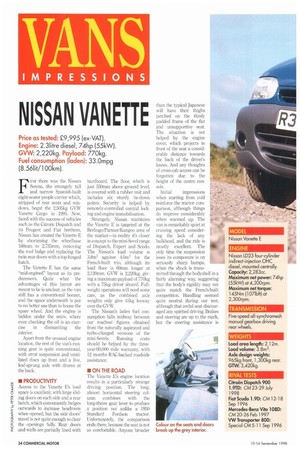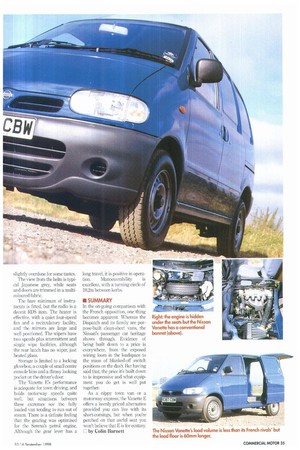NISSAN VANETTE
Page 38

Page 39

If you've noticed an error in this article please click here to report it so we can fix it.
Price as tested: 29,995 (ex-VAT). Engine: 2.31itre diesel, 74hp (55kW). GVW: 2,220kg. Payload: 770kg. Fuel consumption (laden): 33.0mpg (8.5614/100km).
First there was the Nissan Serena, the strangely tall and narrow Spanish-built eight-seater people carrier which, stripped of rear seats and windows, begat the 2,505kg GVW Vanette Cargo in 1995. Now, faced with the success of vehicles such as the Citroen Dispatch and its Peugeot and Fiat brethren, Nissan has created the Vanette E by shortening the wheelbase 160mm to 2,735mm, removing the roof bulge and replacing the twin rear doors with a top-hinged hatch.
The Vanette E has the same "mid-engined" layout as its predecessors. Quite what the advantages of this layout are meant to be is unclear, as the van still has a conventional bonnet, and the space underneath is put to no better use than to house the spare wheel. And the engine is hidden under the seats, where even checking the oil is an exercise in dismantling the interior.
Apart from the unusual engine location, the rest of the van's running gear is quite conventional, with strut suspension and ventilated discs up front and a live, leaf-sprung axle with drums at the back.
• PRODUCTIVITY Access to the Vanette E's load space is excellent, with large sliding doors on each side and a rear hatch, which conveniently bulges outwards to increase headroom when opened, but the side doors' travel is not quite enough to clear the openings fully. Rear doors and walls are partially lined with hardboard. The floor, which is just 550mm above ground level, is covered with a rubber mat and includes six sturdy tie-down points. Security is helped by remotely-controlled central locking and engine immobilisation.
Strangely, Nissan maintains the Vanette E is targeted at the Berlingo/Partner/Kangoo area of the market—in reality its closer in concept to the mini-Sevel range of Dispatch, Expert and Scudo. The Nissan's load volume is 3.8m3 against 4.043 for the French-built trio, although its load floor is 60mm longer at 2,120mm. GVW is 2,220kg, giving a maximum payload of 770kg with a 75kg driver aboard. Fullweight operations will need some care, as the combined axle weights only give 45kg leeway over the GVW.
The Nissan's laden fuel consumption falls midway between our roadtest figures obtained from the naturally aspirated and turbo-charged versions of the mini-Sevels. Running costs should be helped by the threeyear/60,000 mile warranty, with 12 months RAC-backed roadside assistance.
• ON THE ROAD
The Vanette E's engine location results in a particularly strange driving position. The long, almost horizontal steering column combines with the long-throw gear lever to produce a position not unlike a 1950 Standard Fordson tractor. Unfortunately, the comparison ends there, because the seat is not as comfortable. Anyone broader
0.0
than the typical Japanese will have their thighs perched on the thinly padded frame of the flat and unsupportive seat. The situation is not helped by the engine cover, which projects in front of the seat a considerable distance towards the back of the driver's knees, And any thoughts of cross-cab access can be forgotten due to the height of the centre console.
Initial impressions when starting from cold reinforce the tractor comparison, although things do improve considerably when warmed up. The van is remarkably quiet at cruising speed considering the lack of any bulkhead, and the ride is mostly excellent. The only time the suspension loses its composure is on seriously sharp bumps, when the shock is transmitted through the bodyshell in a fairly alarming way, suggesting that the body's rigidity may not quite match the French-built competition. Handling seemed quite neutral during our test. although that awful seat discouraged any spirited driving. Brakes and steering are up to the mark, but the steering assistance is slightly overdone for some tastes.
The view from the helm is typical Japanese grey, while seats and doors are trimmed in a multicoloured fabric.
The bare minimum of instruments is fitted, but the radio is a decent RDS item. The heater is effective, with a quiet four-speed fan and a recirculatory facility, and the mirrors are large and well positioned. The wipers have two speeds plus intermittent and single wipe facilities, although the rear hatch has no wiper, just heated glass.
Storage is limited to a locking glovebox, a couple of small centre console bins and a flimsy looking pocket on the driver's door.
The Vanette E's performance is adequate for town driving, and holds motorway speeds quite well, but situations between these extremes see the fully loaded van tending to run out of steam. There is a definite feeling that the gearing was optimised for the Serena's petrol engine. Although the gear lever has a long travel, it is positive in opera tion. Manoeuvrability is excellent, with a turning circle of 10.2m between kerbs.
• SUMMARY
In the on-going comparison with the French opposition, one thing becomes apparent. Whereas the Dispatch and its family are purpose-built clean-sheet vans, the Nissan's passenger car heritage shows through. Evidence of being built down to a price is everywhere, from the exposed wiring loom in the loadspace to the mass of blanked-off switch positions on the dash. But having said that, the price it's built down to is impressive and what equipment you do get is well put together.
As a nippy town van or a motorway express, the Vanette E offers a keenly priced alternative provided you can live with its short-comings, but when you're perched on that awful seat you won't believe that E is for ecstasy n by Cohn Barnett
MODEL Nissan Vanette E ENGINE Nissan 1D23 four-cylinder indirect-injection OHC diesel, mounted centrally. Capacity: 2,283cc. Maximum net power: 74hp (55kW) at 4,200rpm. Maximum net torque: 145Nm (10711aft) at 2,30Orpm.
TRANSMISSION Five-speed all-synchromesh manual gearbox driving rear wheels.
WEIGHTS
Load area length: 2.12m Load volume: 3.8m3. Axle design weights: 965kg front, 1,300k9 rear. GTW: 3,420kg.
RIVAL TESTS Citroen Dispatch 900 1.9TD: CM 23-29 July 1998 Fiat Scud° 1.9D: CM 12-18 Sep 1996 Mercedes-Benz Vito 108D: CM 20-26 Feb 1997 VW Transporter 800: Special CM 5-11 Sep 1996
















































































































